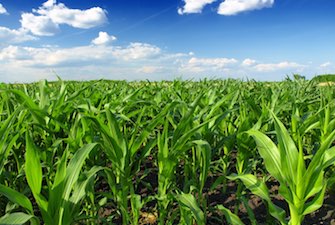 The Monsanto Company (NYSE:MON) of St. Louis, MO, is an American agrochemical and agricultural biotech company that broadly licenses its seed and in-the-seed trait technologies to other seed companies across the globe. The company also produces the weed and grass herbicide Roundup. Recently, Monsanto’s fourth quarter 2015 earnings report posted a net loss of $495 million on the quarter for the corporation, more than triple its $156 million net loss posted in its fourth quarter for 2014. This was coupled with the announcement that Monsanto would implement cost-cutting measures including the elimination of 2,600 jobs over two years, a 12 percent reduction in its total workforce. Weak sales of corn seeds have been cited as a reason for Monsanto’s recent downturn, along with reduced pricing for glyphosate herbicides and foreign currency headwinds. The company is also looking to reduce its activities in Brazil, where it will be getting out of the sugarcane business it runs under the name CanaVialis. Undeterred, Monsanto has just announced a $3 billion accelerated share repurchase agreement.
The Monsanto Company (NYSE:MON) of St. Louis, MO, is an American agrochemical and agricultural biotech company that broadly licenses its seed and in-the-seed trait technologies to other seed companies across the globe. The company also produces the weed and grass herbicide Roundup. Recently, Monsanto’s fourth quarter 2015 earnings report posted a net loss of $495 million on the quarter for the corporation, more than triple its $156 million net loss posted in its fourth quarter for 2014. This was coupled with the announcement that Monsanto would implement cost-cutting measures including the elimination of 2,600 jobs over two years, a 12 percent reduction in its total workforce. Weak sales of corn seeds have been cited as a reason for Monsanto’s recent downturn, along with reduced pricing for glyphosate herbicides and foreign currency headwinds. The company is also looking to reduce its activities in Brazil, where it will be getting out of the sugarcane business it runs under the name CanaVialis. Undeterred, Monsanto has just announced a $3 billion accelerated share repurchase agreement.
However, Monsanto’s financial situation isn’t completely gloomy and its recent earnings report indicates the company expects earnings per share (EPS) to more than double between 2014 and 2019, much of it on the strength of the company’s technology portfolio. Monsanto has been actively pursuing a merger with Swiss-based Syngenta AG (NYSE:SYT), with which the American agrochemical giant believes it can achieve substantial synergies, EPS accretion and a responsible capital structure. Monsanto has also been making some forays into the world of high tech through its Climate Corporation division, which recently unveiled a new digital  platform for analyzing farming data known as the Climate FieldView, a suite of digital tools for analyzing real-time and historic data for crop growth, weather and more.
platform for analyzing farming data known as the Climate FieldView, a suite of digital tools for analyzing real-time and historic data for crop growth, weather and more.
In 2014, Monsanto earned the 86th largest amount of patents from the U.S. Patent and Trademark Office, receiving 478 U.S. patents during that year. This represents an increase of greater than 10 percent over the company’s 2013 patent totals, according to statistics collected by the Intellectual Property Owners Association. Monsanto’s 2014 totals were bested by its American agrochemical rival Dow Chemical (NYSE:DOW) of Midland, MI, which took home 627 U.S. patents in 2014. Monsanto earned 84 U.S. patents during its most recent quarter, a lower quarterly pace of innovation than it enjoyed last year. As the text cluster provided by Innography shows here, most of Monsanto’s recent R&D has focused on corn and soybean, although there is some focus on tomato plants as well.
Monsanto’s Issued Patents: From Soil Nutrient Measuring Devices to Disease Resistant Corn and Soybean
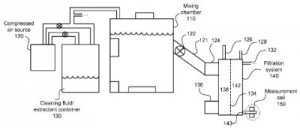 A tool that can be used by farmers in the field to determine accurate measurements of soil nutrient levels is at the center of U.S. Patent No. 9146223, titled Automated Soil Measurement Device. It protects a filtration system of a soil analysis device which has a first chamber coupled to a mixing chamber to receive a liquid from the mixing chamber and coupled to an air source for pressurizing the first chamber, a second chamber having a drain and coupled to the first chamber for receiving a filtered liquid mixture, a measurement cell coupled to the second chamber’s drain for analyzing the filtered liquid mixture and a filter disposed between the two chambers that generates a filtered liquid mixture by removing particulate from a liquid mixture passing through the filter. This technology is designed to increase the speed of testing soil for nutrient levels over conventional lab testing options, which can take a week or two, making it difficult to make the right fertilizer choices at the appropriate time.
A tool that can be used by farmers in the field to determine accurate measurements of soil nutrient levels is at the center of U.S. Patent No. 9146223, titled Automated Soil Measurement Device. It protects a filtration system of a soil analysis device which has a first chamber coupled to a mixing chamber to receive a liquid from the mixing chamber and coupled to an air source for pressurizing the first chamber, a second chamber having a drain and coupled to the first chamber for receiving a filtered liquid mixture, a measurement cell coupled to the second chamber’s drain for analyzing the filtered liquid mixture and a filter disposed between the two chambers that generates a filtered liquid mixture by removing particulate from a liquid mixture passing through the filter. This technology is designed to increase the speed of testing soil for nutrient levels over conventional lab testing options, which can take a week or two, making it difficult to make the right fertilizer choices at the appropriate time.
We’ve been focusing recently on technological solutions to the issue of pest control in agricultural settings and we noted a recent Monsanto innovation in pesticides, reflected within U.S. Patent No. 9121035, entitled Insecticidal Compositions and Methods for Making Insect-Resistant Transgenic Plants. It discloses a method for enhancing the accumulation of a first insecticidal protein in a recombinant host cell by contemporaneously expressing the insecticidal protein with a second insecticidal protein, both proteins being under the control of heterologous promoters in the host cell. This invention results in plants grown with higher levels of pesticidally active proteins to protect against corn rootworm and Lygus bugs.
Monsanto’s 2005 acquisition of vegetable and fruit seed producer Seminis, Inc., continues to pay dividends for the corporation as readers can see in a couple of patents which have recently issued from the USPTO. U.S. Patent No. 9125354, which is titled Squash Hybrid LEBEHH9044 and Parents Thereof, claims a squash plant and seed having a first set of chromosomes of squash line ZGN-EH-09-7554. The squash plant protected here exhibits desirable traits for commercial squash production and is well suited for the development of new lines based the elite nature of the plant’s genetic background. Another invention which was initially filed by 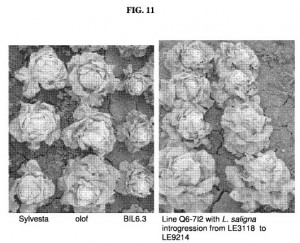 Seminis can be seen within U.S. Patent No. 9072271, titled Agronomically Elite Lettuce with Quantitative Bremia lactuca Resistance. This patent protects a lettuce seed containing an allele conferring resistance to Bremia lactucae and lacking a second allele conferring resistance to Lactuca saligna and conferring traits in adventitious shoots, bubbled leaves and reduced plant diameter. This innovation is intended to produce lettuce with a natural resistance to downy mildew without conferring some undesirable agronomic traits which are genetically linked to the resistance traits.
Seminis can be seen within U.S. Patent No. 9072271, titled Agronomically Elite Lettuce with Quantitative Bremia lactuca Resistance. This patent protects a lettuce seed containing an allele conferring resistance to Bremia lactucae and lacking a second allele conferring resistance to Lactuca saligna and conferring traits in adventitious shoots, bubbled leaves and reduced plant diameter. This innovation is intended to produce lettuce with a natural resistance to downy mildew without conferring some undesirable agronomic traits which are genetically linked to the resistance traits.
Some of Monsanto’s research and development in soybean plants can be witnessed in U.S. Patent No. 9095103, titled Methods and Compositions for Selecting Soybean Plants Resistant to Brown Stem Rot. This patent protects a method of producing a population of soybean plants having an allele that confers brown stem rot resistance by genotyping a soybean plant from a first population of soybean plants with respect to genomic DNA markers indicative of brown stem rot resistance, selecting a soybean plant comprising the said genomic DNA markers and growing a second population of soybean plants from the soybean plant. This innovation is intended to cut down on the labor and time required to select soybean plants resistant to brown stem rot, a major disease of soybean grown in the northern U.S. and Canada affecting up to 20 million bushels of soybeans each year. The breeding of corn crops which are also less susceptible to plant disease is outlined within U.S. Patent No. 9119365, titled Methods and Compositions for Goss’ Wilt Resistance in Corn. This patent claims a method of producing a population of corn plants having an allele associated with resistance to Goss’ wilt by genotyping a first population of corn plants having an allele associated with Goss’ wilt resistance, selecting corn plants containing the said allele from the first population and growing a second population from the selected corn plant to create a population of corn plants having an allele for Goss’ wilt resistance. This method of breeding corn plants is intended to reduce the harmful effects of Goss’ wilt, which affects corn crops throughout the western portions of the U.S. corn belt and can create black water soaked spots in crops leading to loss of yield.
Patent Applications of Note: From Disease-Resistant Spinach to Drought-Tolerant Plants
More patent applications related to the Seminis acquisition were still adding to Monsanto’s IP holdings as is reflected in U.S. Patent Application No. 20150208599, entitled Cucumber Hybrid SV4196CD and Parents Thereof. This patent application would protect a cucumber plant and seed having at least a first set of chromosomes of either cucumber line BAF-BAS10226-BF or BAF-BAS10222-MO. This invention is intended to produce cucumber varieties which have a higher crop yield along with other desirable plant traits. Disease-resistant vegetables were another area of R&D focus for Seminis as can be seen within U.S. Patent Application No. 20150240256, entitled Compositions and Methods for Peronospora Resistance in Spinach. This patent application discloses a Spinacia oleracea spinach plant comprising, in its genome, a heterozygous combination of alleles conferring broad-spectrum resistance to Peronospora farinosa f. sp. Spinaciae. The resulting plant has a higher resistance to the pathogen which causes downy mildew to form in the world’s most commonly cultivated spinach species to reduce the economic impact of that disease.
Despite the effects of glyphosate pricing on Monsanto’s fourth quarter results, the company is forging ahead with R&D in this field by pursuing herbicide inventions such as the one that would be protected by U.S. Patent Application No. 20150164082, titled Aqueous Concentrated Herbicidal Compositions Containing Glyphosate Salts and Dicamba Salts. It claims a low volatility aqueous herbicidal composition including a glyphosate component comprising the monoethanolamine salt of glyphosate, a dicamba component comprising the diglycolamine salt of dicamba and a surfactant to create a composition that contains 450 grams acid equivalent of a total active herbicide loading of the two components. The herbicidal innovation is convenient for agricultural workers to apply and reduces the risk of mixing errors when using tanks of different herbicides. Herbicides which exhibit more stable characteristics when used in the field are discussed within U.S. Patent Application No. 20150272116, filed under the title Auxin Herbicidal Mixtures. This would protect a method of producing an herbicidal mixture by combining an auxin herbicide with a first cation and a salt adjuvant as a second cation, where the salt is selected from a group including ammonium salt, phosphonium salt and salt containing a nitrogen heterocycle. This innovative composition is designed to produce a herbicide featuring auxin, which affects cell wall plasticity and nucleic acid metabolism, which can become excessively volatile when used with a co-herbicide.
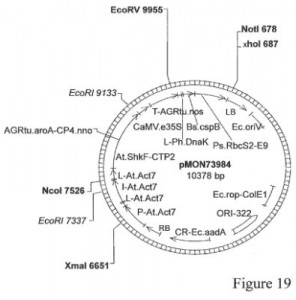 Drought has been gripping parts of the United States and we’ve already covered drought-related technological innovations here on IPWatchdog, so we were intrigued to see Monsanto trying to address this problem with the innovation detailed within U.S. Patent Application No. 20150197769, entitled Methods for Enhancing Stress Tolerance in Plants and Compositions Thereof. It would protect a drought tolerant transgenic plant which includes a cold shock protein in a recombinant DNA molecule which confers a resistance to drought. This invention seeks to improve both the abiotic and biotic tolerance of commercially valuable crops by introducing cold shock proteins, which are believed to help plants survive in drought conditions.
Drought has been gripping parts of the United States and we’ve already covered drought-related technological innovations here on IPWatchdog, so we were intrigued to see Monsanto trying to address this problem with the innovation detailed within U.S. Patent Application No. 20150197769, entitled Methods for Enhancing Stress Tolerance in Plants and Compositions Thereof. It would protect a drought tolerant transgenic plant which includes a cold shock protein in a recombinant DNA molecule which confers a resistance to drought. This invention seeks to improve both the abiotic and biotic tolerance of commercially valuable crops by introducing cold shock proteins, which are believed to help plants survive in drought conditions.
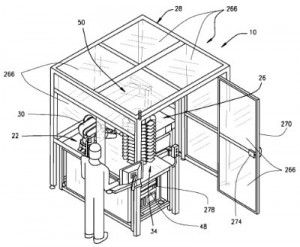 A technology meant to take some of the painstaking labor out of properly distributing extremely fine granular seeds is the focus of U.S. Patent Application No. 20150177110, which is titled Small Object Distribution Automation. It discloses an automated small particle distribution system for transferring small articles from source tubes to destination tubes which includes a loading deck to store and provide both source tube trays and destination tube trays, each tray having a plurality of either source tubes or destination tubes, and then a work deck operable to receive selected source tube and destination tube trays from the loading deck, aspirate specific amounts of small objects stored in the source tubes and deposit the aspirated small objects into selected destination tubes without cross-contamination of small objects. This system automates the work of sorting and distributing small seeds, such as Arabidopsis seeds, which are relatives of cabbage and mustard, to reduce the time needed and the risk of human error.
A technology meant to take some of the painstaking labor out of properly distributing extremely fine granular seeds is the focus of U.S. Patent Application No. 20150177110, which is titled Small Object Distribution Automation. It discloses an automated small particle distribution system for transferring small articles from source tubes to destination tubes which includes a loading deck to store and provide both source tube trays and destination tube trays, each tray having a plurality of either source tubes or destination tubes, and then a work deck operable to receive selected source tube and destination tube trays from the loading deck, aspirate specific amounts of small objects stored in the source tubes and deposit the aspirated small objects into selected destination tubes without cross-contamination of small objects. This system automates the work of sorting and distributing small seeds, such as Arabidopsis seeds, which are relatives of cabbage and mustard, to reduce the time needed and the risk of human error.
Finally, we thought our readers would enjoy exploring a crop innovation which is intended to benefit the wood treatment industry and not food production, outlined within U.S. Patent Application No. 20150275047, titled High PUFA Oils for Industrial Applications. The method for coating a substrate that would be protected here involves applying a coating composition of a drying oil including a polyunsaturated fatty acid having three or more carbon-carbon double bonds to the substrate; the coating composition also includes a second composition which has a polyunsaturated fatty acid having four or more carbon-carbon double bonds. The resulting composition, derived from transgenic soybeans, can be used as a wood sealant in combination with creosote to increase the amount of oil sealed within the wood and reduce the amount of pressure needed to treat wood, resulting in a cost savings.

![[IPWatchdog Logo]](https://ipwatchdog.com/wp-content/themes/IPWatchdog%20-%202023/assets/images/temp/logo-small@2x.png)

![[[Advertisement]]](https://ipwatchdog.com/wp-content/uploads/2023/01/2021-Patent-Practice-on-Demand-1.png)
![[Advertisement]](https://ipwatchdog.com/wp-content/uploads/2024/04/UnitedLex-May-2-2024-sidebar-700x500-1.jpg)
![[Advertisement]](https://ipwatchdog.com/wp-content/uploads/2024/04/Artificial-Intelligence-2024-REPLAY-sidebar-700x500-corrected.jpg)
![[Advertisement]](https://ipwatchdog.com/wp-content/uploads/2024/04/Patent-Litigation-Masters-2024-sidebar-700x500-1.jpg)

![[Advertisement]](https://ipwatchdog.com/wp-content/uploads/2021/12/WEBINAR-336-x-280-px.png)
![[Advertisement]](https://ipwatchdog.com/wp-content/uploads/2021/12/2021-Patent-Practice-on-Demand-recorded-Feb-2021-336-x-280.jpg)
![[Advertisement]](https://ipwatchdog.com/wp-content/uploads/2021/12/Ad-4-The-Invent-Patent-System™.png)






Join the Discussion
No comments yet.